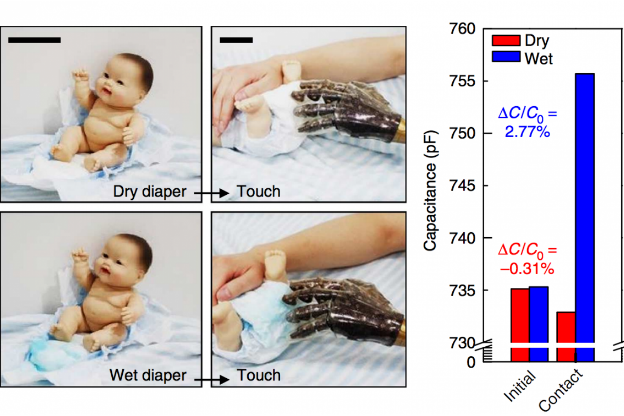Researchers in Korea and the US have developed the first realistically stretchy artificial skin that can take cues from its environment and transmit messages back to the wearer's nervous system. Made from a flexible plastic containing an array of ultra-thin gold and silicon sensors, this new skin can tell its wearer if they're holding a hot or cold drink, or touching something dry, damp, soft, or hard.
Prosthetic limbs have come a long way in the past few years. Just a few months ago, researchers in Sweden announced that they had created the first prosthetic arm that can plug directly into a patient's bones, nerves and muscles, and translate their thoughts into actions. Another team has created self-healing prosthetic skin, and another has managed to imbue their prosthetics with 1,000 times more sensitivity than actual human skin. But in all these cases, there's no way for the wearer to know if they're holding something that's incredibly hot, or if they're about to drop something because they don't have a proper grip on it.
So researchers led by Dae-Hyeong Kim from Seoul National University developed artificial skin made from a stretchy, transparent silicone material called polydimethylsiloxane (PDMS) that can be wrapped around prosthetic limbs.
It boasts 400 sensors per square millimetre, which produce an electrical signal when they're stretched or squished, and can sense the temperature of what they're touching. It also contains sensors fitted with devices called capacitors, which absorb moisture, and then measure how much it affects the material's capacity to store an electrical charge. This measurement is then used to instantaneously determine the level of moisture that the artificial skin has come into contact with.
And how did they test this? By creepily prodding wet and dry nappies, of course:
 Kim et al./Nature Communications
Kim et al./Nature Communications
The material is so clever, its sensors can be programmed to allow the right degree of stretch according to where it's sitting on a prosthetic hand. According to Talbot, the team used motion-capture cameras to figure out exactly how a real hand moves and the skin around it stretches, and adjusted their artificial skin accordingly. So in areas that don't need much stretching - say, the fingertips - the team focussed on packing the material full of sensors.
"If you have these sensors at high resolution across the finger, you can give the same tactile touch that the normal hand would convey to the brain," one of the team, Roozbeh Ghaffari from a US-based technology start-up called MC10 told David Talbot at MIT's Technology Review.
But in other areas that need more flexibility - such as the base of the fingers and the wrist - the team engineered the material to have room to stretch and expand up to 16 percent.
Publishing in Nature Communications, the team says they've also made the skin feel extra realistic, by fitting it with heating devices so it's warm to the touch. "For prosthetic devices and artificial skin to feel natural, their temperature profile must be controlled to match that of the human body," they write.
It's all very well for the skin to pick up on all the things it's touching, but it's useless unless it can tap into the wearer's nervous system and tell them about it. This is the next step in the team's research, as Talbot explains at Technology Review:
"In a crude demonstration of such an interface, Dae-Hyeong Kim connected the smart skin to a rat's brain and was able to measure reactions in the animal's sensory cortex to sensory input. This did not, however, show whether, or to what extent, the rat was feeling heat, pressure, or moisture."
"To tell the exact kinds of feeling," Kim told him, "we need to move onto larger animals, which would be our future work."
Source: MIT Technology Review
